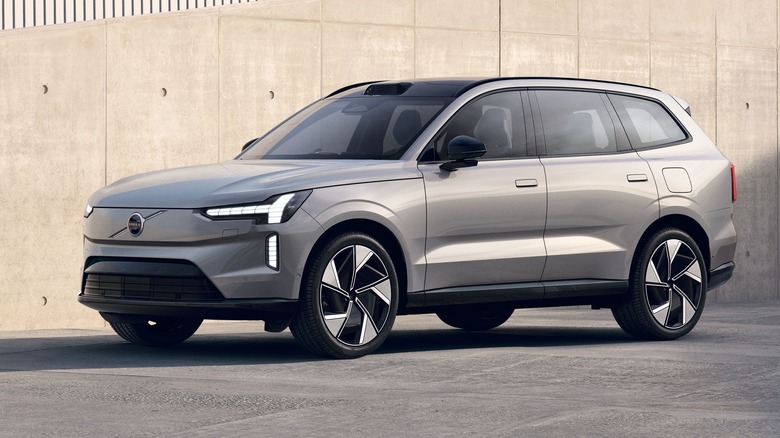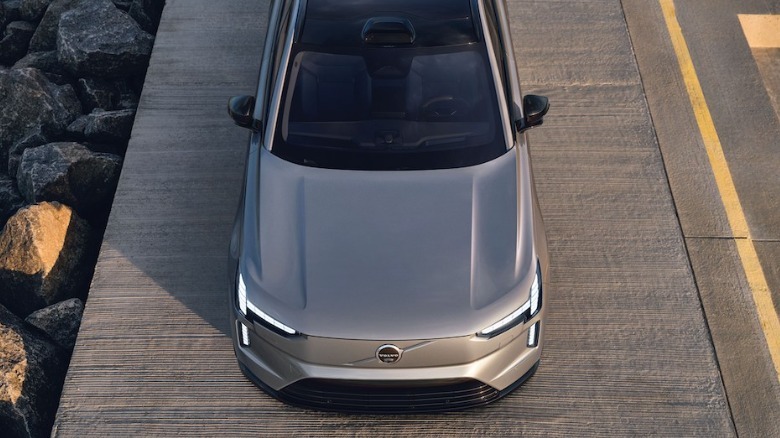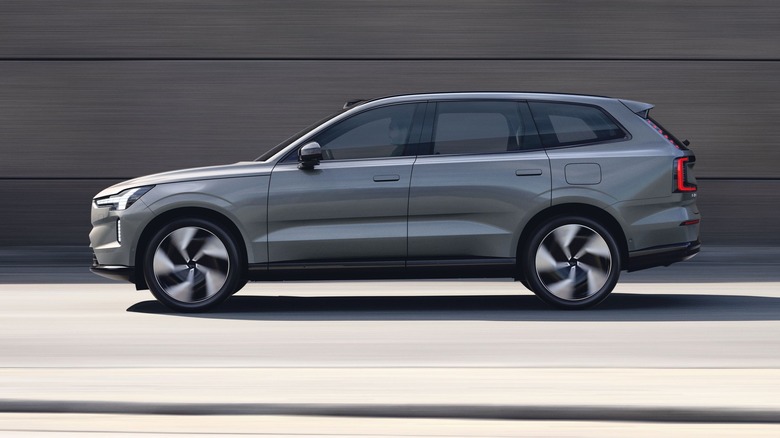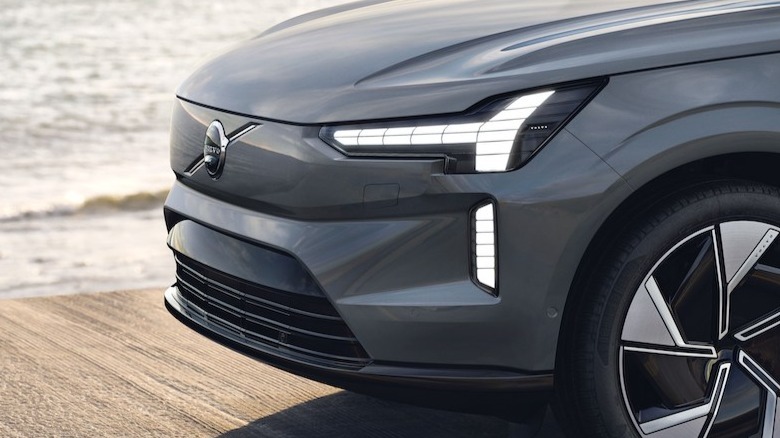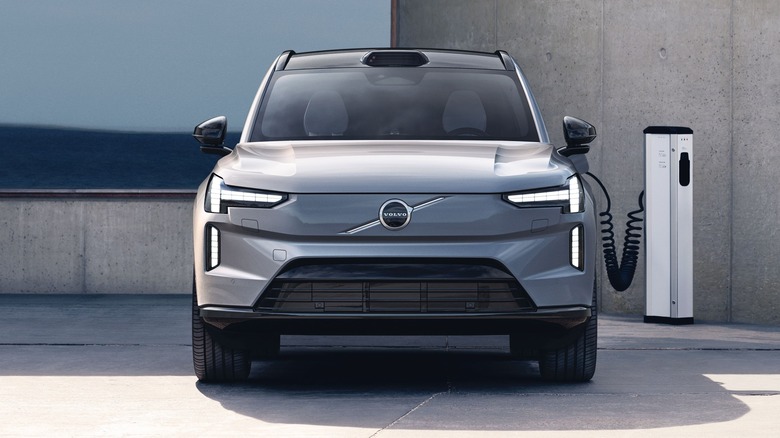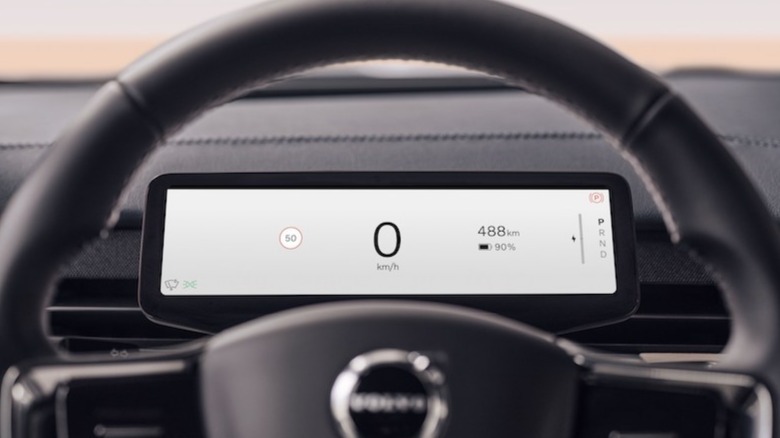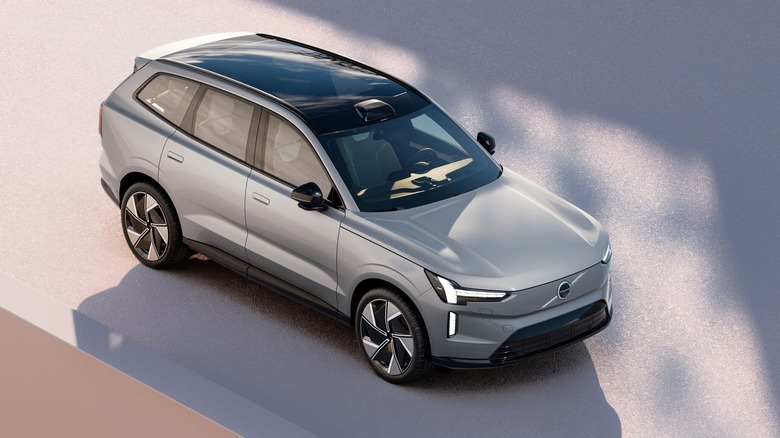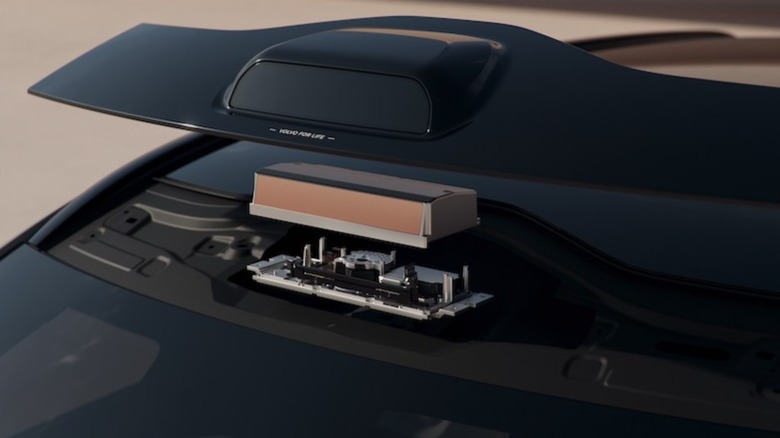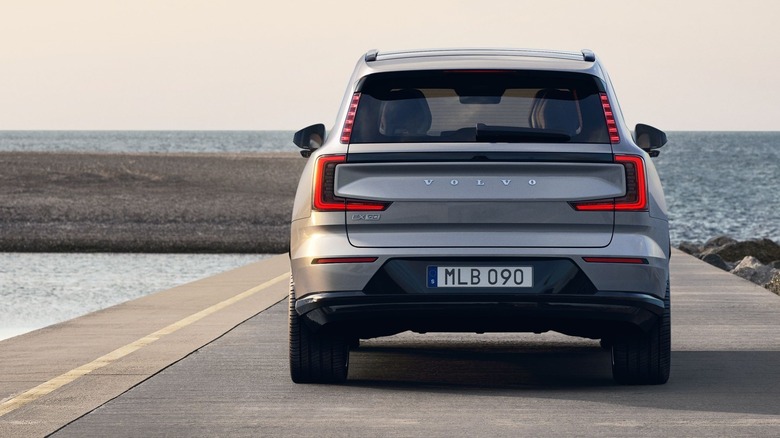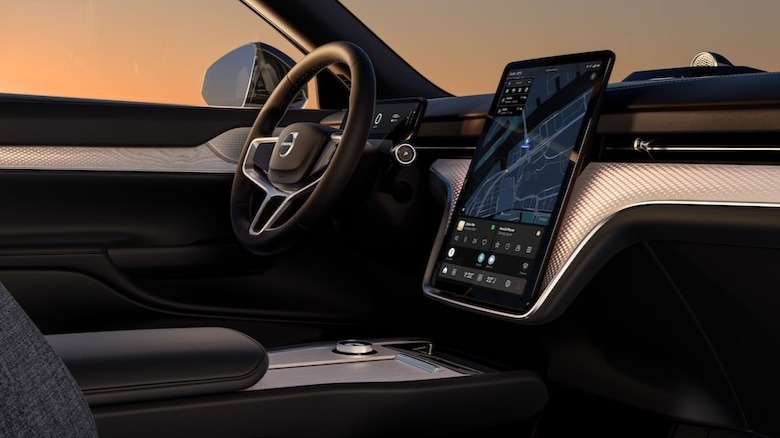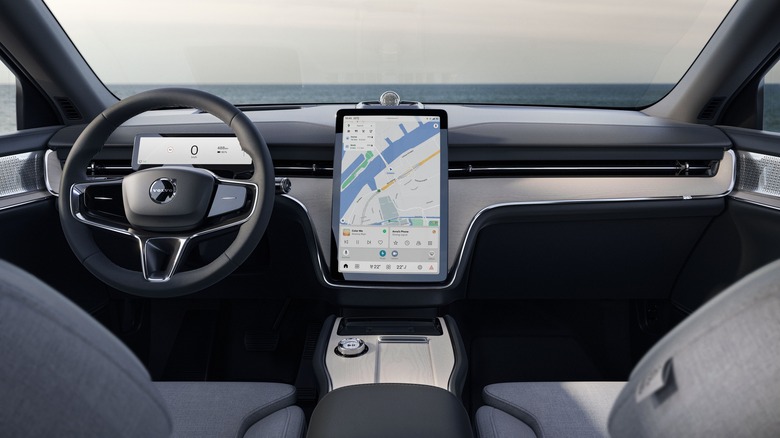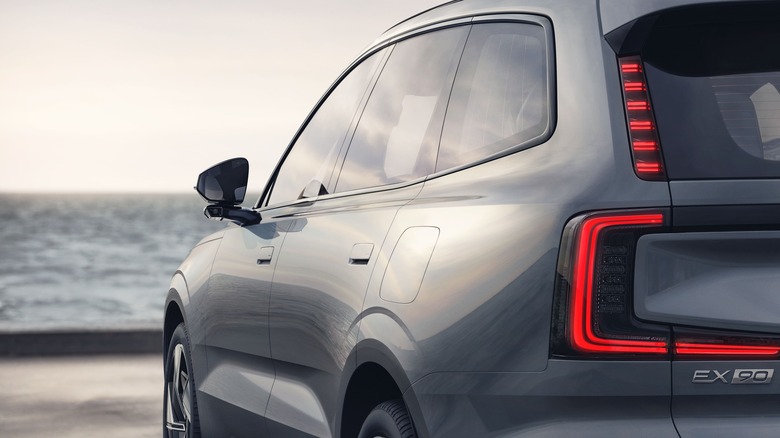Volvo EX90 Revealed As 300 Mile Electric SUV With Autonomy In Its Future
Big electric SUVs with seating for seven are still relatively rare, and that's just one reason why the Volvo EX90 could make a splash. Unveiled today, and set to arrive on U.S. roads in early 2024, the EV upgrade to the XC90 promises the Swedish style and flexibility that Volvo is known for, combined with up to 300 miles of estimated range, a considerable cabin tech upgrade, and autonomous driving support in the future.
While it's a new car for Volvo, the EX90 does build on a platform we've seen before. That's the SPA2 architecture that Volvo's electric-first sibling will use for the 2024 Polestar 3. Unsurprisingly there'll be plenty of overlap — in hardware at least — between the two SUVs. However, Polestar and Volvo are insistent that the value for customers will be fairly distinct between their models.
The biggest decider, most likely, is just how many seats you require. The Polestar 3 intentionally outfits its cabin for five people, maximum; the Volvo EX90, in contrast, will be a "true" seven-seat vehicle, the automaker promises, following on from that capacity being one of the big selling points of the XC90.
A familiar silhouette with striking new lights
It's fair to say the aesthetic is familiar. While Polestar may have pushed the envelope with its Polestar 3, including an unusual front spoiler that bisects the hood and helps direct airflow across the swooping roofline, the EX90 sticks closely to the formula Volvo has developed for the XC90 over the past few years. Side-on, in fact, you'd be forgiven for mistaking it for that existing SUV — first unveiled back in 2015 — albeit on big, aerodynamically-minded alloy wheels.
Only from the front and the rear do things really begin to distinguish themselves. The EX90's fascia builds on that of the XC40 Recharge, doing away with a traditional grille in favor of a blanked-out nose through which the Volvo logo slices diagonally like a railroad junction. The automaker's Thor's hammer headlamps are carried over, in silhouette at least, but they're now made up of multiple individual segments, as are the daytime running lights in the lower bumper.
From the rear, there are echoes of the C40 Recharge's distinctive LED lights that flank its glass, with six-segment bars on the EX90. Crisply-styled lower lamps bracket an oversized Volvo logo. The end result is modern but not outlandish like some BEVs, and likely to fit neatly and fairly unobtrusively into the school run. It should also be practical, too, with what looks like a decent-sized trunk and a front trunk — or frunk — too.
The most range from an electric Volvo
What the EX90 will offer above and beyond those earlier Recharge-branded EVs is more range. Volvo says it's expecting up to 300 miles from a full charge — a healthy step up compared to the 223 miles that an XC40 Recharge is EPA rated for — or the 226 miles of a C40 Recharge. When it does come time to plug in, there'll be DC fast charging support for taking the battery from 10% to 80% in about 30 minutes, Volvo suggests. Plug & Charge will support automatic charging session initiation and billing, without having to swipe a card or open an app.
That all makes it much more competitive with other large electric SUVs, as does the promised performance. Initially, Volvo will be offering a single configuration: a twin-motor setup for electric all-wheel drive, with a 111 kWh battery and a total of 496 horsepower and 671 lb-ft of torque. That's comparable to the 2024 Polestar 3 with the optional $6,000 Performance Pack the SUV will be offered with.
Down the line, Volvo is likely planning other versions, potentially with more or less power along with more or less range. There's also the promise of bi-directional charging, with the EX90 coming hardware-ready to act as a power supply for a home during an outage. It won't be activated at launch, though Volvo does intend to offer a package with a bi-directional home charge station that could — if the market supports it — also allow owners to sell energy from the SUV back into the grid depending on demand.
Built with autonomous driving in mind
What your eye may get caught on is the EX90's windshield bump. The SUV is the first in Volvo's line-up to include a LiDAR sensor, fruit of the automaker's investment in Luminar, which has been mounted up high so as to provide the best view of the road ahead for the 3D scanning array. The few rival cars out there already including LiDAR, Volvo points out, typically mount those sensors lower down such as in the grille, and in the process limit just how much of the environment the vehicle can see.
That works with the EX90's cameras, radar, and other sensors, to give the SUV a 360-degree perspective of the world around it. The data is fed into the NVIDIA DRIVE Xavier and Orin processors, running Volvo's in-house software, for obstacle and accident avoidance, improvements in lane-changing assistance, and more. Pilot Assist, Volvo's assisted highway driving system, will be able to support steering between lanes, for example.
Inside, meanwhile, those same processors tap cabin sensors and cameras to measure eye gaze concentration and flag up warnings if the driver is distracted or sleepy. Should the driver actually fall asleep, or have a medical emergency preventing them from safely controlling the EV, the EX90 should be able to automatically bring itself to a safe stop and summon assistance.
Lifetime updates over a 5G connection
What all these sensors and processing grunt won't do, at least, to begin with, is make the EX90 a self-driving car. That's something Volvo says it's working on, promising that the hardware in the electric SUV will be sufficient for unsupervised driving. It's taking a fairly conservative approach, though, to actually rolling out such features.
Down the line, though, that should just mean a software upgrade. The EX90 has a baked-in 5G cellular connection as standard and will allow for over-the-air (OTA) updates for the driver assistance systems as well as the Google-powered infotainment. It'll also work for streaming media, in addition to showing information on charging station locations.
That'll include which are currently occupied or available, updated in real-time, and bringing status updates on your charging session once plugged in via the Volvo Cars app. The same app will support things like smart charging scheduling, prioritizing battery top-ups when electricity rates at home are low, as well as control over the eventual bi-directional power system. Volvo isn't just seeing it as being useful for outages, either, but envisages EX90 owners switching between grid power and the charge in their electric SUV's battery depending on how expensive their utility is at any point in time.
Volvo's most minimalistic cabin yet
Step inside, meanwhile, and there's a clean, bright cabin that embraces Scandinavian minimalism even more enthusiastically than previous Volvo models. The centerpiece is a 15-inch portrait touchscreen, running Android Automotive OS for access to Google Maps, Google Assistant, and the Google Play store. A second, smaller display behind the steering wheel will show the driver key things like speed and charge status, and the graphics will be built using Unreal Engine and run on Qualcomm's Snapdragon Cockpit Platform.
Wireless Apple CarPlay will be supported, and smartphone-as-a-key will be standard. The EX90 will have UWB (ultra Wideband), and support features like temporary key sharing so that other people can access and drive the car.
A Bowers & Wilkins audio system will be available, with Dolby Atmos support. It'll also include speakers built into the headrests. Physical controls will be kept to a minimum, with a volume knob and media control in the center console, along with back-illuminated buttons on the steering wheel. Support for Google-powered remote actions will allow owners to do things like check battery status or turn on the HVAC system to warm or cool the cabin from their home smart speaker.
Under $80,000 for a well-equipped EX90
The EX90 is, unsurprisingly, only Volvo's first big step into electrification. The automaker now plans to unveil a new, fully-electric car each year, and by 2030 it's aiming to only sell such vehicles. It's not just the drivetrain that it's focusing on, either, but all of the materials which go into its cars.
For example, the EX90 will use approximately 15% recycled steel, and 25% recycled aluminum. About 15% of the total plastics in the EV — or more than 105 pounds — will be recycled or bio-based.
Full pricing for the Volvo EX90 will be shared closer to the EV's arrival in dealerships. In the U.S., that's expected to begin in early 2024 with the SUVs intended to be built at its Ridgeville, South Carolina plant; other markets will get EX90 built in China. The pre-order books are opening today, with customers set to actually place those orders in fall 2023. A "well-equipped" EX90 is expected to come in at under $80,000, Volvo says.
